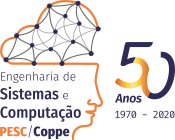Reconstrução Tri-Dimensional do Crânio Humano
Autores
|
3192 |
Angela Klemt
|
1455,1456
|
|
3193 |
1455,1456
|
Informações:
Publicações do PESC
Um sistema de computação gráfica de reconstrução 3D de estruturas da anatomia humana para o ensino da medicina e odontologia foi desenvolvido. O sistema foi implementado em microcomputador IBM compatível (12 MHz) com placa VGA. Um conjunto de imagens de Tomografia Computadorizada de uma cabeça humana foi utilizado na avaliação do sistema. (A distância entre os 110 cortes tomográficos de 2 mm.) Cada imagem digitalizada com resolução de 200 x 300 pixels e 256 níveis de cinza (8 bits) foi segmentada utilizando-se limiar adequado a identificação de suas estruturas ósseas. As bordas externas de cada estrutura foram então detectadas e associadas aquelas de cortes vizinhos. Devido as características do crânio, tal como complexidade anatômica da região visceral, esta etapa h efetuada semi-automaticamente. Para representação 3D do crânio, triângulos são formados a partir do contorno dos ossos. Aproximadamente 27.200 triângulos são assim definidos e o modelo 3D h exibido com projeção paralela, eliminação das linhas ocultas e sombreamento baseado na profundidade. Escalonamento e rotação em torno de um eixo arbitrário podem também ser efetuados. As etapas de reconstrução e exibição são executadas em cerca 8 min. A reconstrução do crânio humano foi considerada adequada, pois estruturas ósseas de dimensão reduzida (i.e.processos estilóides) podem ser reconhecidas com facilidade. A qualidade dos resultados alcançados e a flexibilidade na concepção do sistema permitem seu emprego na reconstrução de estruturas menos complexas, porem importantes no ensino da anatomia.
For the teaching of medicine and dentistry a system for the development of 3D computer models of the human anatomy has been developed, together with a graphics interface for its presentation on screen. The system is based on a microcomputer and the model is defined by image processing of a set of Computerized Tomography (CT) slices.
The system was developed and tested on a set of 110 CT slices taken from a conserved human head, wih a resolution in the z-axis of 2mm. The imagens were diglitized with a frame grabber (220 x 300 pixels) and 256 grey-levels (8 bits). They were then segmentated by grey-level thresholding to identify bone. The result was visually analized by a specialist and considered satisfatory. The borders were traced by an edge-following algorithm and the structures thus identified were numbered in order to link them with those in neighbouring slices. This determination of the continuity of 3D objects is carried out semiautomatically in the region of the visceral skull, wkereas
the neural skull and the mandíbula represent the simple case. The result of the process is the definition of the outline of each structure in each slice ând information on how they are connected in the third dimension, which is then stored, to be used in the generation of the computer graphics.
In order to present the model graphically, triangles are fitted to the outlines of the bones. Scaling and rotation around any arbitrary axis in 3D can then be applied, followed by image creation based on parallel projection and hidden-line removel.
The task was implemented on an IBM-PC compatible computer (12 MHz) with VGA screen. For the model approximately 27.200 triangles were defined and 30 image creation took about 8 minutes for each viewing angle. The reconstruction of the skull was successful and it is therefore expected that the techniques can readily be applied to other (generally simpler) anatomical regions.





